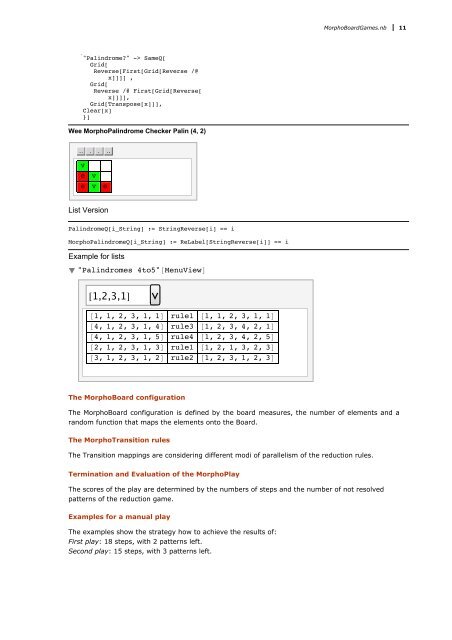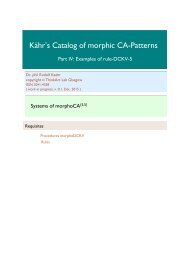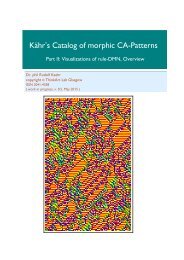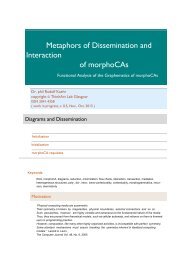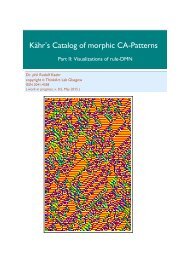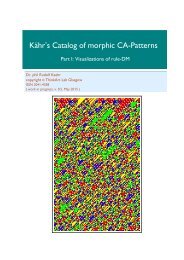Towards a new Paradigm of Board Games
"There is no reason that forces the game industry to restrict itself on a paradigm of games that is repetitive, addictive, regressive and is denying the right of the user to develop his/hers intellectual capabilities of creativity. It is a strategic decision of the game industry to stupidify its costumers." ThinkArt Lab To introduce the paradigm of morphic (board) games, I start with two simple questions. Why are classical games producing regressive addiction and boredom? What are the differences between classical and morphic games? My first answers to the questions might be summarized as follows: Classical games are based on the perceptive acts of identification and separation of the elements of the game by the rules of the game. Morphic Games are involved into differentiations and structurations of interactive and reflectional patterns (morphograms) in complex constellations. For a more conceptual answer of the two questions I connect the proposed new kind of games to the theory and practice of morphogrammatics. What do I understand by morphogrammatics? Morphogrammaitics is a pre-semiotic theory of inscription. It is studying and formalizing the 'deep-structure' of semiotics. Mathematically, morphograms, as the fundamential patterns of morphogrammatics, are representations of Stirling numbers of the second kind. Formal semiotics consists of an sign repertoire and rules of maipulating its signs. This is established by a strict difference of operators and oprands (signs). In contrast, morphograms are playing a double role: they are involved in a chiastic interplay of patterns (operands) and rules (operators). This is in decisive conterast to identity-based semiotic systems that are based on atomic signs. Strings of signs are based on a set of signs with cardinality m and its potentiation (n): m^n. Hence for m=4 and n=4, there are exactly 4^4 = 256 different semiotic strings possible. But on a morphogrammatical level there are just exactly Sn(4,4) = 1+6+7+1=15 morphograms for m=n=4 possible. In this sense, those 15 morphograms are presenting the 'deep-structure' of the set of semiotic strings of length 4.
"There is no reason that forces the game industry to restrict itself on a paradigm of games that is repetitive, addictive, regressive and is denying the right of the user to develop his/hers intellectual capabilities of creativity.
It is a strategic decision of the game industry to stupidify its costumers." ThinkArt Lab
To introduce the paradigm of morphic (board) games, I start with two simple questions.
Why are classical games producing regressive addiction and boredom?
What are the differences between classical and morphic games?
My first answers to the questions might be summarized as follows:
Classical games are based on the perceptive acts of identification and separation of the elements of the game by the rules of the game.
Morphic Games are involved into differentiations and structurations of interactive and reflectional patterns (morphograms) in complex constellations.
For a more conceptual answer of the two questions I connect the proposed new kind of games to the theory and practice of morphogrammatics.
What do I understand by morphogrammatics?
Morphogrammaitics is a pre-semiotic theory of inscription. It is studying and formalizing the 'deep-structure' of semiotics.
Mathematically, morphograms, as the fundamential patterns of morphogrammatics, are representations of Stirling numbers of the second kind.
Formal semiotics consists of an sign repertoire and rules of maipulating its signs. This is established by a strict difference of operators and oprands (signs).
In contrast, morphograms are playing a double role: they are involved in a chiastic interplay of patterns (operands) and rules (operators).
This is in decisive conterast to identity-based semiotic systems that are based on atomic signs. Strings of signs are based on a set of signs with cardinality m and its potentiation (n): m^n. Hence for m=4 and n=4, there are exactly 4^4 = 256 different semiotic strings possible.
But on a morphogrammatical level there are just exactly Sn(4,4) = 1+6+7+1=15 morphograms for m=n=4 possible. In this sense, those 15 morphograms are presenting the 'deep-structure' of the set of semiotic strings of length 4.
You also want an ePaper? Increase the reach of your titles
YUMPU automatically turns print PDFs into web optimized ePapers that Google loves.
BiSymTest[x] =<br />
TabView[<br />
Grid /@<br />
{x ,<br />
"Palindrome" -> SameQ[<br />
Grid[<br />
Reverse[First[Grid[Reverse /@<br />
x]]]] ,<br />
Grid[<br />
Reverse /@ First[Grid[Reverse[<br />
x]]]],<br />
Grid[Transpose[x]]],<br />
Clear[x]<br />
}]<br />
Morpho<strong>Board</strong><strong>Games</strong>.nb 11<br />
Wee MorphoPalindrome Checker Palin (4, 2)<br />
« Å▸ ¡<br />
v<br />
e v<br />
e v e<br />
List Version<br />
PalindromeQ[i_String] := StringReverse[i] == i<br />
MorphoPalindromeQ[i_String] := ReLabel[StringReverse[i]] == i<br />
Example for lists<br />
"Palindromes 4to5"@MenuViewD<br />
@1,2,3,1D<br />
@1, 1, 2, 3, 1, 1D rule1 @1, 1, 2, 3, 1, 1D<br />
@4, 1, 2, 3, 1, 4D rule3 @1, 2, 3, 4, 2, 1D<br />
@4, 1, 2, 3, 1, 5D rule4 @1, 2, 3, 4, 2, 5D<br />
@2, 1, 2, 3, 1, 3D rule1 @1, 2, 1, 3, 2, 3D<br />
@3, 1, 2, 3, 1, 2D rule2 @1, 2, 3, 1, 2, 3D<br />
The Morpho<strong>Board</strong> configuration<br />
The Morpho<strong>Board</strong> configuration is defined by the board measures, the number <strong>of</strong> elements and a<br />
random function that maps the elements onto the <strong>Board</strong>.<br />
The MorphoTransition rules<br />
The Transition mappings are considering different modi <strong>of</strong> parallelism <strong>of</strong> the reduction rules.<br />
Termination and Evaluation <strong>of</strong> the MorphoPlay<br />
The scores <strong>of</strong> the play are determined by the numbers <strong>of</strong> steps and the number <strong>of</strong> not resolved<br />
patterns <strong>of</strong> the reduction game.<br />
Examples for a manual play<br />
The examples show the strategy how to achieve the results <strong>of</strong>:<br />
First play: 18 steps, with 2 patterns left.<br />
Second play: 15 steps, with 3 patterns left.


